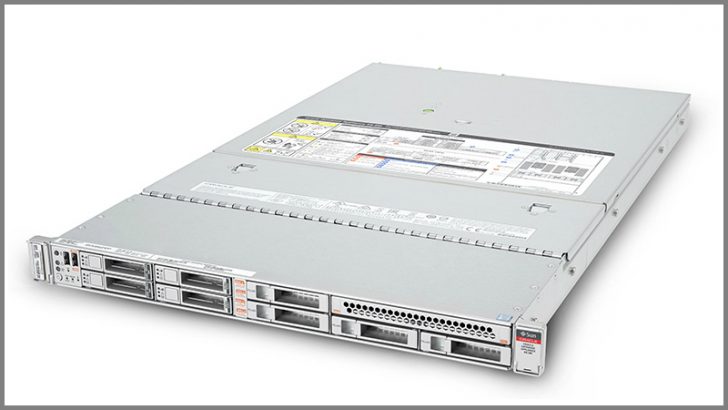
Oracle has announced two new database appliances. The X6-2S and the X6-2M are aimed at SME’s looking to deploy a single instance database or several smaller databases. Oracle will hope that this will boost the revenue of their hardware division after a poor showing during the last quarter. The problem for Oracle is that while they promote the cloud there are fewer companies looking to deploy on-premises database solutions.
The two new devices are quite similar in specification. Both devices will support Oracle Database Standard Edition 2 and Oracle Database Enterprise Edition databases up to 5TB in size. There are both, according to Oracle easy to deploy and can backup and archive to Oracle Public Cloud. For companies that need low latency access to data they will be welcome.
Specifications Oracle database appliance
Both servers are 1U rack mountable units that makes them ideal for small office environments. The Oracle Database Appliance X6-2S contains a 10-core Intel Xeon processor E5-2630 v4 and 128 GB of main memory. This is expandable to expandable to 384 GB. The only difference the two devices is that the X6-2M can double this. It comes with 2 Intel processors and 256GB of memory expandable up to 768GB. Both appliances support dual 10GBase-T network connections. Support for a single 10GbE SFP+ is in the PCIe expansion bus. Oddly, while there appears to be a spare PCIe expansion slot it is not available for use according to the specifications.
Both appliances come with 6.4TB of high-bandwidth NVM Express (NVMe) flash memory. This can be doubled to 12.8TB. Backing up the data does not need to be done locally as the systems easily replicate data to the Oracle Cloud. This ties in the whole Oracle technology stack neatly.
LifeLock sees ODA benefits immediately
One company that is taking advantage of the Oracle database appliance is Lifelock. Lifelock is a provider of proactive identity theft protection services for consumers. They also offer identity risk and credit worthiness assessment for enterprises. Founded in 2005 and listed (NYSE:LOCK)in 2012 with more than 4.4 million members it found that the on-premises solution delivered significant advantages. Key to this was the reduction in latency to under 4 milliseconds.
Jacqueline Hufford-Jenson, Senior Manager, Database Administration, LifeLock commented: “Bringing in Oracle Database Appliances definitely reduced the complexity of our environment and allowed us to support our 25X data growth over the past few years. Today, using the Oracle Database Appliance straight out of the box, we get significantly reduced latency, which has played a role in helping us grow as a company.”
Can the ODA help Oracle
The fact that the deployment of the appliance for so rapid helped Lifelock make their decision. Oracle estimate that deployment takes as little as 30 minutes. Prices start at $18,000 for the 2S version and the 2M version is around 50% more.

So why have Oracle aimed the solution at the mid-market at a time when companies are flocking to the cloud? Jim Gargan, senior vice president of Oracle Converged Infrastructure commented: “We’re excited to bring the power, simplicity and capabilities of Oracle’s Engineered Systems in at a price point that allows every organization to save time and money. With the family of database appliances, Oracle offers built-in expertise for single-instance database and high-availability deployments, while providing a bridge between on-premises systems and the cloud, enabling all of our customers to capitalize on their investment.”
This is a brave decision but there will be companies out there who still require on-premises solutions. Not for themselves perhaps but when deploying into clients. Both Epsilon and NEC Australia have use cases that support this view. Epsilon, a multichannel marketing services company deploys appliances in midmarket deployments. NEC Australia provide ODA as PAAS (Platform as a Service). They see three benefits of doing this:
- Cut customers’ ownership cost by 40 percent
- Reduce implementation time by 80 percent
- Provide a 50 percent boost in performance for previous solution.
Conclusion

This may seem like a backward step for Oracle. However, it is actually addressing a market sector that is not ready to go to cloud. It will be interesting to see whether it gains more traction in the SME market or in companies looking to sell on-premises solutions to that market.
Peter Rutten, Analyst, IDC Computing Platforms Group commented: “Since Oracle owns the entire stack, its systems are fully hardware-software integrated, pre-tested, and optimized from silicon to applications. … (They) should help small and medium-sized businesses put a fully operational entry-level Oracle database in place—apparently no screwdrivers required.”
It will be interesting to see whether ODA sales slow down or reverse the negative trend of hardware sales at Oracle.


























